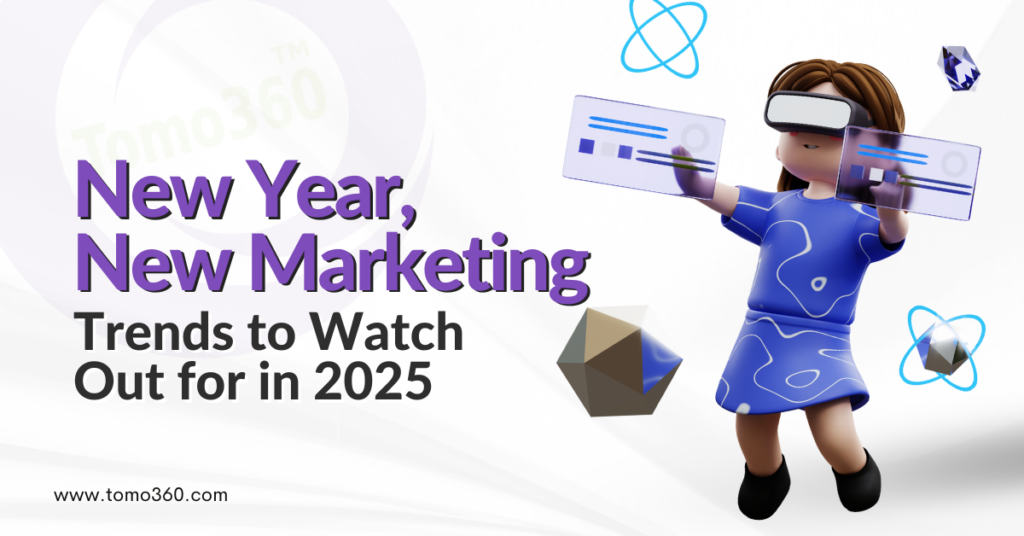
As we kick off 2025, the marketing world continues to evolve at an unprecedented pace. Emerging technologies, shifting consumer behaviors, and the demand for authenticity are driving new trends that businesses and nonprofits alike must navigate. From hyper-personalization to purpose-driven branding, marketers are rethinking strategies to stay relevant and impactful.
In this blog, we’ll dive into five key marketing trends to watch in 2025 and explore how you can prepare for the future of advertising and consumer engagement.
1. The AI-Powered Marketing Revolution
Artificial intelligence (AI) is not just a buzzword—it’s the driving force behind some of the most transformative changes in marketing. In 2025, AI is powering everything from predictive analytics to content creation, enabling marketers to target their audiences with greater precision and efficiency than ever before.
Key areas where AI is revolutionizing marketing:
- Hyper-Personalization: AI allows businesses to deliver customized experiences at scale. From email campaigns that dynamically adapt to user behavior to real-time product recommendations, personalization is key to building consumer loyalty.
- Streamlined Processes: Tools like AI chatbots and content generation software are freeing up time for marketers to focus on strategy and creativity.
For more insights on how AI is shaping marketing, Forbes’ guide on digital marketing trends for 2025 and beyond is a must-read.
2. Experiential Marketing: Creating Immersive Connections
Experiential marketing has been gaining traction, and in 2025, it’s becoming a cornerstone of successful campaigns. This strategy blends physical and digital experiences to create immersive, memorable interactions that deepen customer engagement.
Emerging technologies like augmented reality (AR) and virtual reality (VR) are taking experiential marketing to new heights. Here’s how brands are using these tools:
- Virtual Try-Ons: Fashion and beauty brands are enabling customers to “try on” products using AR, reducing friction in the purchasing process.
- Immersive Storytelling: Nonprofits and socially conscious businesses can transport audiences into the heart of their mission using VR, fostering emotional connections that drive action.
Google’s guide to 2025 digital marketing trends explores how brands are blending technology with creativity to meet evolving consumer expectations.
3. Purpose-Driven Marketing and Sustainability
Today’s consumers expect more than just products—they demand accountability and action. Sustainability and purpose-driven branding are no longer optional in 2025; they’re essential for businesses to stay competitive.
Brands that focus on ethical practices and transparency will earn the trust and loyalty of their audiences. Strategies to adopt include:
- Highlighting eco-friendly initiatives, such as sustainable sourcing or carbon offset programs.
- Sharing your company’s commitment to diversity, equity, and inclusion.
- Being transparent about your goals and progress in tackling social and environmental challenges.
This trend isn’t limited to for-profit organizations. Nonprofits, too, must communicate their values effectively to inspire action. Our nonprofit marketing tips blog outlines how mission-driven organizations can leverage these strategies to connect with their supporters.
4. Consumer Trends: From Gen Z to AI-Native Audiences
Consumer behavior continues to evolve as younger generations gain purchasing power. In 2025, Gen Z and emerging “AI-native” consumers (those who have grown up with AI technologies) are reshaping how brands interact with their audiences.
Key characteristics of these audiences:
- Tech-Savvy and Mobile-First: These consumers rely heavily on mobile devices and expect seamless, on-the-go interactions with brands.
- Authenticity Over Perfection: Younger generations value authenticity and relatability over polished, traditional advertising. Social media campaigns that focus on real stories and behind-the-scenes glimpses often perform better than overly curated content.
- Preference for Ethical Brands: Gen Z especially prioritizes brands that align with their social and environmental values.
To capture these audiences, businesses must meet them where they are—on platforms like TikTok, Instagram, and other emerging channels. Experimenting with short-form videos, influencer partnerships, and interactive content will be key in 2025.
5. The Long-Term Evolution of Marketing
While the trends of 2025 are exciting, it’s also important to consider where marketing is headed in the next decade. By 2030, we can expect marketing to become even more immersive, automated, and integrated into our daily lives.
Future trends to watch:
- Expanded Use of AI: AI will likely handle more complex tasks, such as long-form content creation and advanced audience segmentation.
- Growth of the Metaverse: As metaverse platforms become more mainstream, brands will have new opportunities to engage with consumers in virtual environments.
- Emerging Industries: Sectors like renewable energy, sustainable technology, and personalized health and wellness are poised for rapid growth, creating new opportunities for marketers to innovate.
Planning for the long term means adapting your strategies to these shifts while staying true to your brand’s core values.
—
As 2025 unfolds, marketing will continue to transform in ways that prioritize innovation, personalization, and purpose. By embracing new technologies like AI, creating immersive experiences, and aligning your brand with your audience’s values, you can set yourself up for success in the years to come.
Whether you’re a small business or a nonprofit organization, staying ahead of these trends is key to making an impact. Ready to elevate your marketing strategy for 2025 and beyond? Contact us to create customized campaigns that keep you ahead of the curve.
